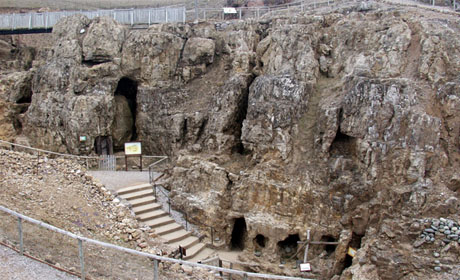Great Orme Bronze Age Mine
Conwy, Wales

The Great Orme is a spectacular headland of limestone lying to the north-west of Llandudno. It is 3km long and 2 km wide, and rises to 207m at the summit. The ancient copper mines on the Great Orme are located in Carboniferous Limestone of the Visean stage formed around 330 million years ago, and represent one of the most astounding archaeological discoveries of recent time.

The main rock type is limestone, which is locally dolomitised, and there are minor units of limy mudstone and sandstone. Copper mineralisation and dolomitisation are closely associated with fractures and faults. Hydrothermal fluids passing along the fractures created veins of the copper mineral, chalcopyrite, occasionally with the lead mineral, galena. Other common minerals are the copper carbonates, malachite and azurite.
Mining of the copper ores began in the early Bronze age and continued until around 600BC. The basic tools of prehistoric miners, found when the ancient mines were rediscovered in the late 20th century, were stone hammers, animal bones and antler picks.
Over recent years mining engineers, cavers and archaeologists have mapped the tunnels of the ancient workings as well large areas of the surface landscape, revealing remnants of bell pits aligned with geological faults. In extent the Great Orme mines are among the largest prehistoric mines in Europe and perhaps the world.
Mining recommenced in the late 17th century and continued into the 19th century. The main mining area was near the halfway tram station, where shafts and spoil tips can still be seen.
You can explore some of the workings, and find out more about life of the Bronze Age miners by visiting the Great Orme Mines visitor attraction.
Text: Howard Colley
Related Links
Grid Reference
- SH 767 833
- Great Orme Copper Mine © Alan Simkins (source Geograph.org.uk) Creative Commons Attribution-ShareAlike 2.0 license.
- Inside the Mines © Richard Hoare (Source Geograph.org.uk) Creative Commons Attribution-ShareAlike 2.0 license.

October 13 - 21
Theme: 'Earth Science in our lives'
